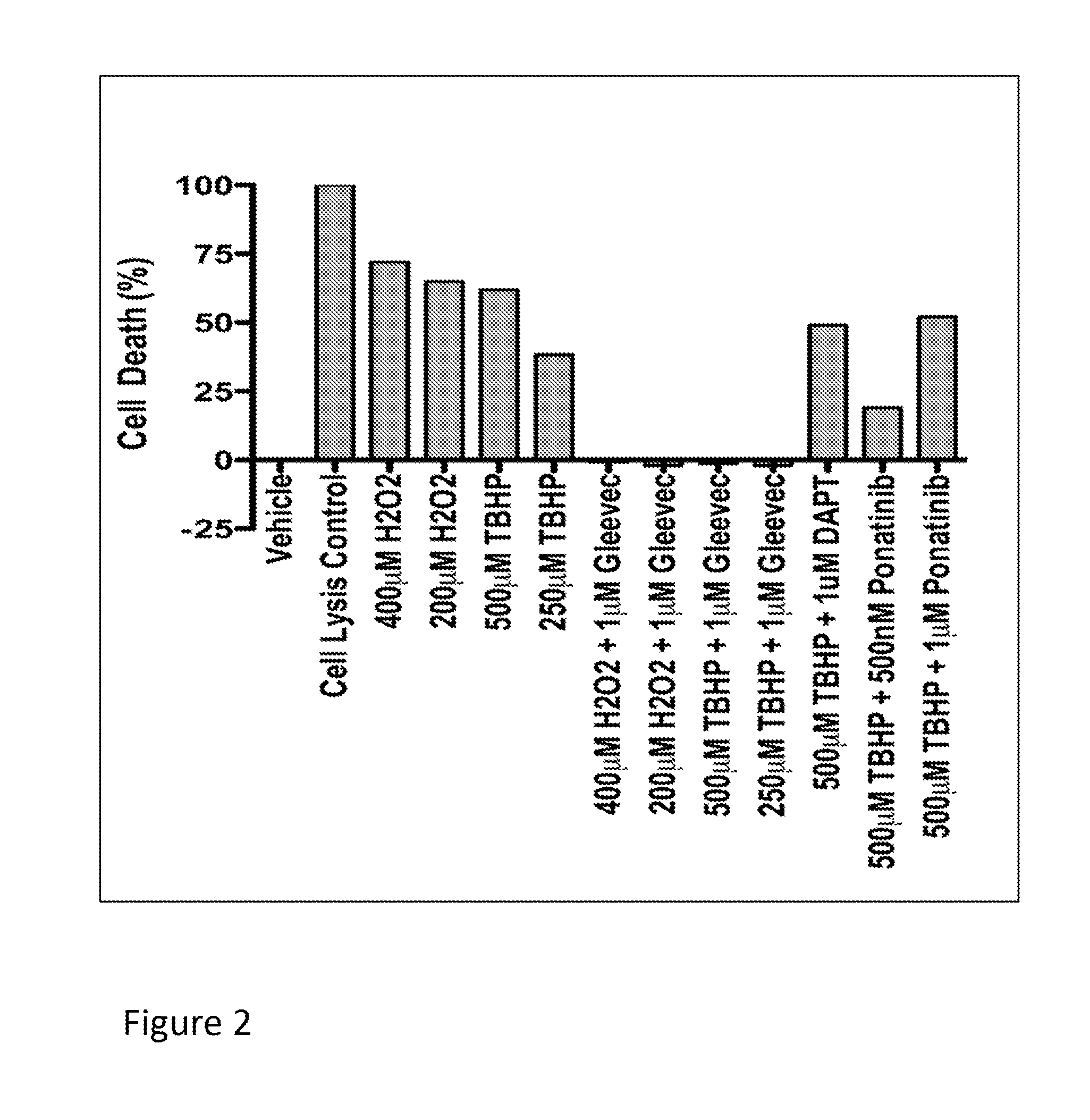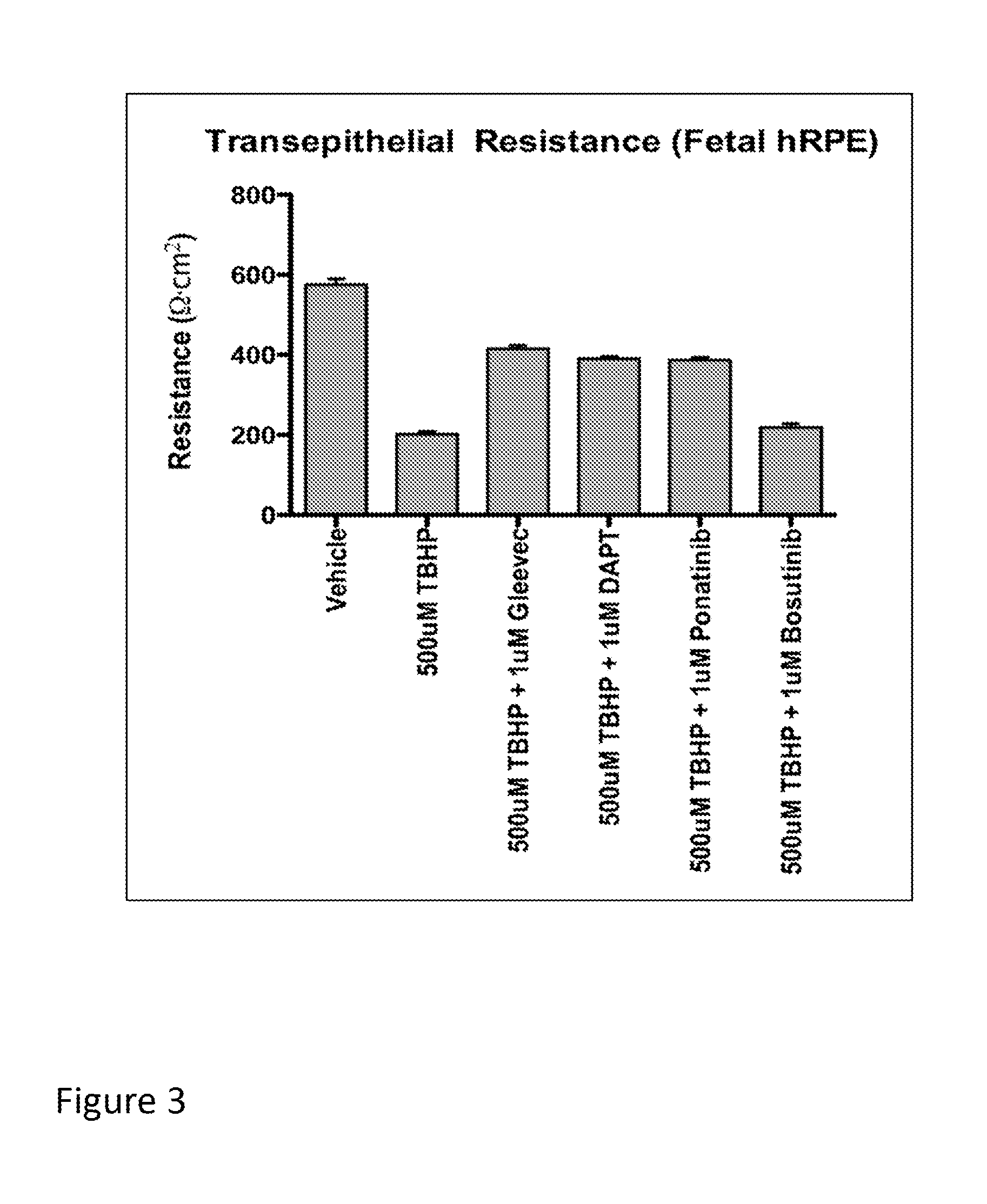Compositions And Methods For Inhibiting Drusen
a technology of compound and drusen, applied in the field of compound compositions, can solve the problems of rapid vision loss, lack of medical treatment, and loss of macular photoreceptor function, and achieve the effects of inhibiting or reducing the formation of drusen, preventing or inhibiting drusen-associated disorders, and reducing or inhibting drusen
- Summary
- Abstract
- Description
- Claims
- Application Information
AI Technical Summary
Benefits of technology
Problems solved by technology
Method used
Image
Examples
example 1
Retinal Pigment Epithelial Stem Cell (RPESC)-Based Model of Drusen Formation
[0078]This example describes experiments showing that the expression of various drusen-related proteins, and genes encoding them, is unregulated in RPE derived from RPESC, after exposing the RPE to oxidative stress in vivo. The results show that RPE derived from such stem cells can be used as an in vivo model for drusen formation, e.g., to indentify compounds that modulate drusen formation.
[0079]More specifically, retinal pigment epithelial (RPE) cells are derived from RPE stem cells (RPESCs) and cultured using methods described, e.g., by Salero et al. (Cell Stem Cell (2011) 10:88-95) and / or in U.S. patent application publication No. 2009 / 0274667. Briefly, human RPE cells are dissected from cadaveric human eyes and cultured in RPE-THT media (DMEM / F12, 1x THT, 1% L-glutamine, 1% penicillin / streptomycin, 1% N1 supplement) from Sigma-Aldrich (St. Louis, Mo.) containing 10% fetal bovine serum (FBS) tapered down ...
example 2
RPE Cell-based Screening Assay
[0083]This example describes experiments in which the RPESC-based model of drusen formation, exemplified in Example 1, supra, is used to identify compound that modulate (e.g., reduce or inhibit) drusen formation in vitro. Compounds identified in such assays are thus useful for modulating (e.g., reducing or inhibiting) the formation of drusen in vitro or in vivo, and may therefore be useful, e.g., in therapeutic compositions and methods for treating or inhibiting conditions associated with drusen formation, including AMD and, in particular, dry AMD.
[0084]Specifically, RPE cells are prepared from RPESC and treated with either TBHP or H2O2 (to induce oxidative stress) or vehicle (for control) as described in Example 1, above. To investigate a test compound's effect on drusen expression, RPESC are incubated in media containing test compound or vehicle (as a control) during treatment with H2O2 or TBHP as described in Example 1, supra.
[0085]In this example, t...
example 3
In Vivo Testing of Candidate Drusen Inhibitors
[0093]Test compounds, including imatinib mesylate and other compounds identified as candidate drusen inhibitors, e.g., in the in vitro assays demonstrated supra, may also be tested in vivo, using animal models of AMD. For example, Malek et al. (Proc. Natl. Acad. Sci. U.S.A. (2005) 102:11900-11905) describe a mouse model, referred to as the APOE4-HFC mouse of AMD that can be used to test compounds in vivo. Generally speaking, a candidate or test compound's effect on drusen formation can be tested by administering the compound to such as mouse (e.g., orally, intravenously, parentally or intraocularly) and its effect on drusen formation evaluated by comparing histological changes in the retina or RPE of treated and untreated mice.
[0094]It is to be understood that while the invention has been described in conjunction with the detailed description thereof, the foregoing description is intended to illustrate and not limit the scope of the inve...
PUM
| Property | Measurement | Unit |
|---|---|---|
| molecular weight | aaaaa | aaaaa |
| resorption | aaaaa | aaaaa |
| size | aaaaa | aaaaa |
Abstract
Description
Claims
Application Information
 Login to View More
Login to View More - R&D
- Intellectual Property
- Life Sciences
- Materials
- Tech Scout
- Unparalleled Data Quality
- Higher Quality Content
- 60% Fewer Hallucinations
Browse by: Latest US Patents, China's latest patents, Technical Efficacy Thesaurus, Application Domain, Technology Topic, Popular Technical Reports.
© 2025 PatSnap. All rights reserved.Legal|Privacy policy|Modern Slavery Act Transparency Statement|Sitemap|About US| Contact US: help@patsnap.com



